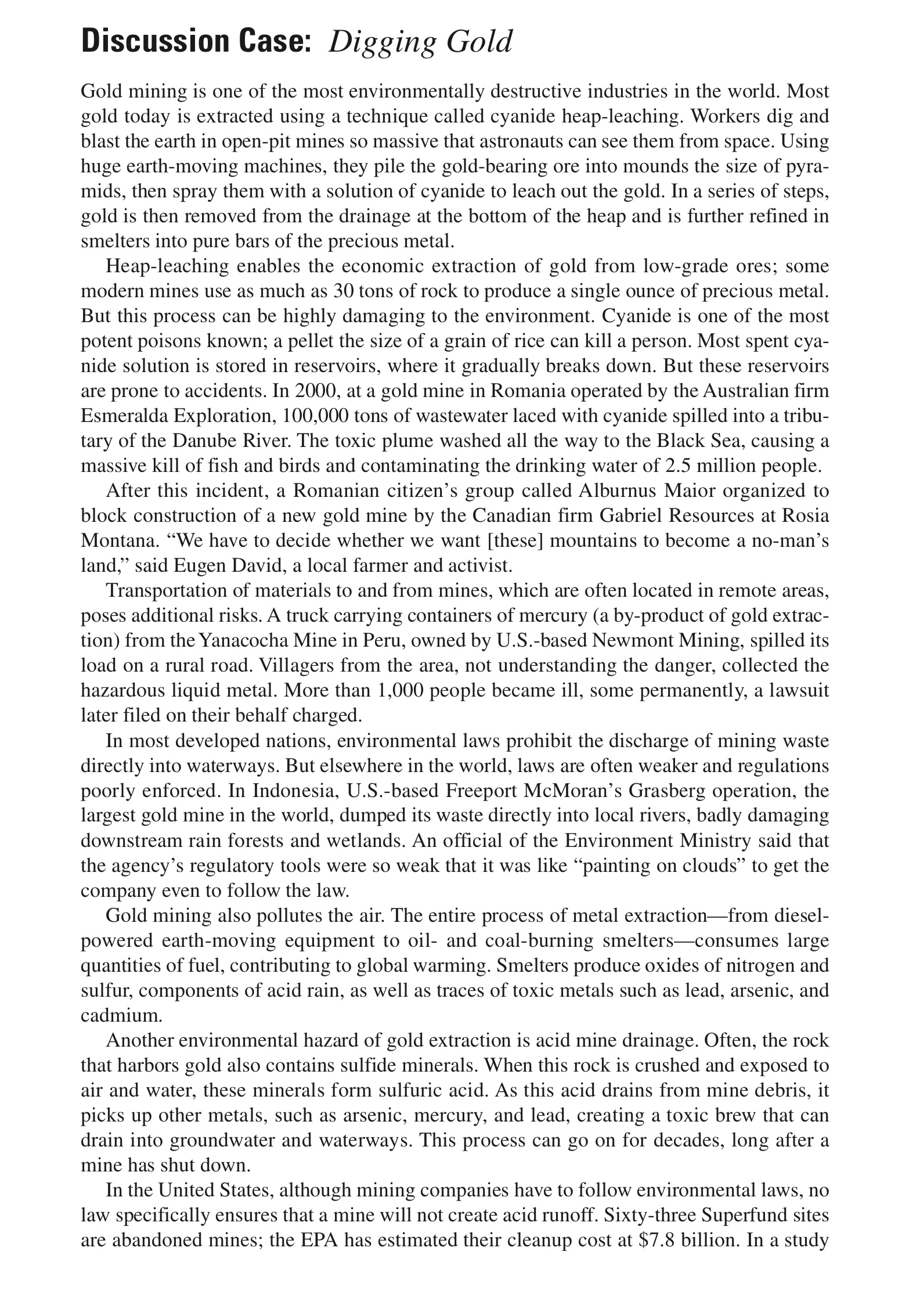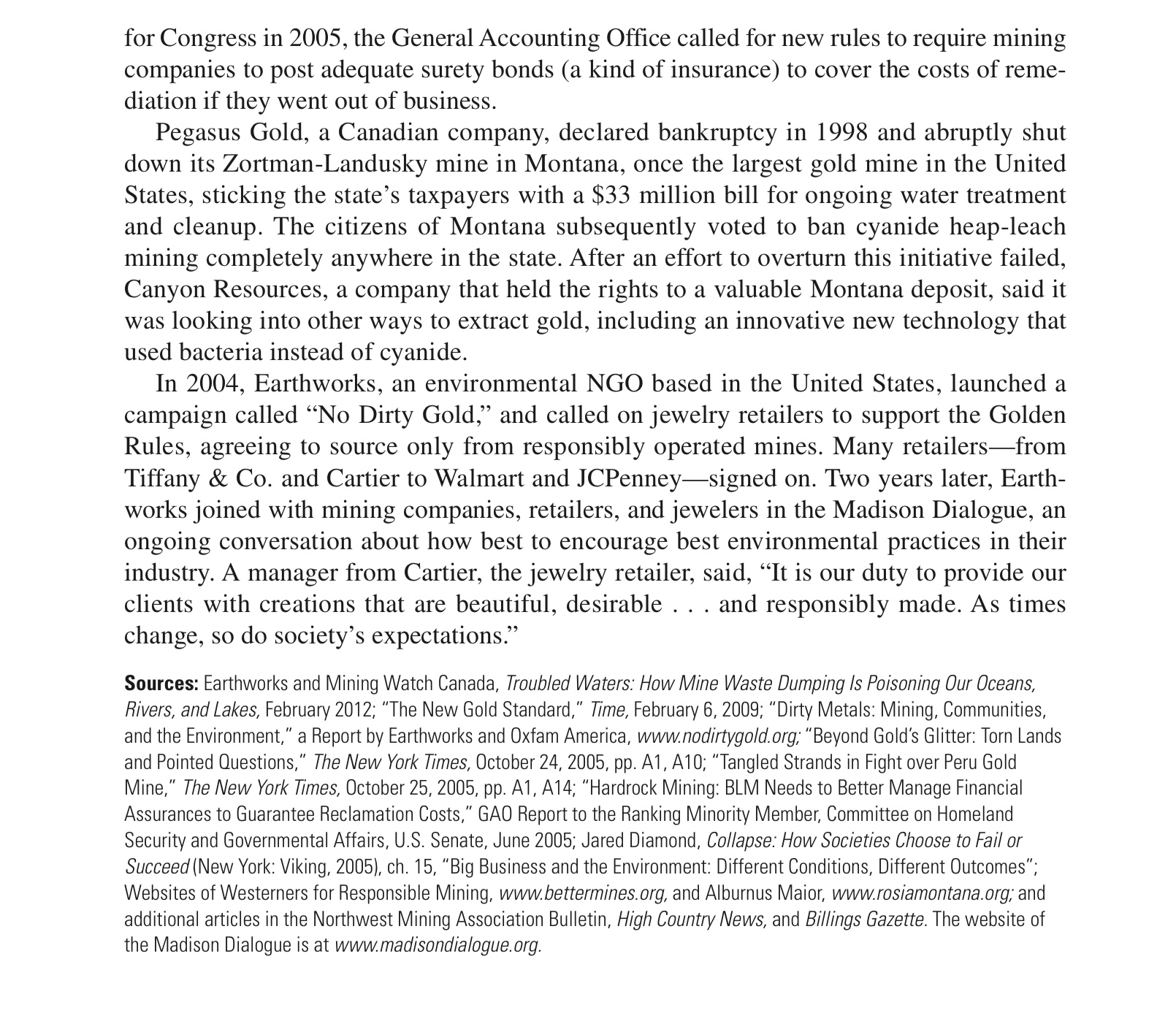Discussion Case: Digging Gold Gold mining is one of the most environmentally destructive industries in the world. Most gold today is extracted using a technique called cyanide heapleaching. Workers dig and blast the earth in open-pit mines so massive that astronauts can see them from space. Using huge earthmoving machines, they pile the gold-bearing ore into mounds the size of pyra- mids, then spray them with a solution of cyanide to leach out the gold. In a series of steps, gold is then removed from the drainage at the bottom of the heap and is further rened in smelters into pure bars of the precious metal. Heapleaching enables the economic extraction of gold from lowgrade ores; some modern mines use as much as 30 tons of rock to produce a single ounce of precious metal. But this process can be highly damaging to the environment. Cyanide is one of the most potent poisons known; a pellet the size of a grain of rice can kill a person. Most spent cya nide solution is stored in reservoirs, where it gradually breaks down. But these reservoirs are prone to accidents. In 2000, at a gold mine in Romania operated by the Australian rm Esmeralda Exploration, 100,000 tons of wastewater laced with cyanide spilled into a tribu tary of the Danube River. The toxic plume washed all the way to the Black Sea, causing a massive kill of sh and birds and contaminating the drinking water of 2.5 million people. After this incident, a Romanian citizen's group called Albumus Maior organized to block construction of a new gold mine by the Canadian rm Gabriel Resources at Rosia Montana. \"We have to decide whether we want [these] mountains to become a noman's land,\" said Eugen David, a local farmer and activist. Transportation of materials to and from mines, which are often located in remote areas, poses additional risks. A truck carrying containers of mercury (a by-product of gold extrac tion) from the Yanacocha Mine in Peru, owned by U.S.based Newmont Mining, spilled its load on a rural road. Villagers from the area, not understanding the danger, collected the hazardous liquid metal. More than 1,000 people became ill, some permanently, a lawsuit later led on their behalf charged. In most developed nations, environmental laws prohibit the discharge of mining waste directly into waterways. But elsewhere in the world, laws are often weaker and regulations poorly enforced. In Indonesia, U.S.-based Freeport McMoran's Grasberg operation, the largest gold mine in the world, dumped its waste directly into local rivers, badly damaging downstream rain forests and wetlands. An ofcial of the Environment Ministry said that the agency's regulatory tools were so weak that it was like \"painting on clouds\" to get the company even to follow the law. Gold mining also pollutes the air. The entire process of metal extractionfrom diesel powered earthmoving equipment to oil and coalburning smeltersconsumes large quantities of fuel, contributing to global warming. Smelters produce oxides of nitrogen and sulfur, components of acid rain, as well as traces of toxic metals such as lead, arsenic, and cadmium. Another environmental hazard of gold extraction is acid mine drainage. Often, the rock that harbors gold also contains sulfide minerals. When this rock is crushed and exposed to air and water, these minerals form sulfuric acid. As this acid drains from mine debris, it picks up other metals, such as arsenic, mercury, and lead, creating a toxic brew that can drain into groundwater and waterways. This process can go on for decades, long after a mine has shut down. In the United States, althOugh mining companies have to follow environmental laws, no law specically ensures that a mine will not create acid runoff. Sixtythree Superfund sites are abandoned mines; the EPA has estimated their cleanup cost at $7.8 billion. In a study for Congress in 2005, the General Accounting Ofce called for new rules to require mining companies to post adequate surety bonds (a kind of insurance) to cover the costs of reme- diation if they went out of business. Pegasus Gold, a Canadian company, declared bankruptcy in 1998 and abruptly shut down its Zortman-Landusky mine in Montana, once the largest gold mine in the United States, sticking the state's taxpayers with a $33 million bill for ongoing water treatment and cleanup. The citizens of Montana subsequently voted to ban cyanide heapleach mining completely anywhere in the state. After an effort to overturn this initiative failed, Canyon Resources, a company that held the rights to a valuable Montana deposit, said it was looking into other ways to extract gold, including an innovative new technology that used bacteria instead of cyanide. In 2004, Earthworks, an environmental NGO based in the United States, launched a campaign called \"No Dirty Gold,\" and called on jewelry retailers to support the Golden Rules, agreeing to source only from responsibly operated mines. Many retailersfrom Tiffany & C0. and Cartier to Walmart and JCPenneysigned on. Two years later, Earth~ works joined with mining companieS, retailers, and jewelers in the Madison Dialogue, an ongoing conversation about how best to encourage best environmental practices in their industry. A manager from Cartier, the jewelry retailer, said, \"It is our duty to provide our clients with creations that are beautiful, desirable . . . and responsibly made. As times change, so do society's expectations.\" Sources: Earthworks and Mining Watch Canada, Troubled Waters: How Mine Waste Dumping ls Poisoning Our Oceans, Rivers, and Lakes, February 2012; "The New Gold Standard," Time, February 6, 2009; "Dirty Metals: Mining, Communities, and the Environment," 3 Report by Earthworks and Oxfam America, wwwnodirtygoldorg; "Beyond Gold's Glitter: Torn Lands and Pointed Questions," The New York Times, October 24, 2005, pp. A1, A10; "Tangled Strands in Fight over Peru Gold Mine," The New York Times, October 25, 2005, pp. A1, A14; "Hardrock Mining: BLM Needs to Better Manage Financial Assurances to Guarantee Reclamation Costs," GAD Report to the Ranking Minority Member, Committee on Homeland Security and Governmental Affairs, US. Senate, June 2005; Jared Diamond, Collapse: How Societies Choose to Fail or Succeed (New York: Viking, 2005}, ch. 15, "Big Business and the Environment: Different Conditions, Different Outcomes"; Websites of Westerners for Responsible Mining, wwwbetterminescrg, and Alburnus Maior, wwwrosiamontanaorg,' and additional articles in the Northwest Mining Association Bulletin, High Country News, and Billings Gazette. The website of the Madison Dialogue is at wwwmadisondialogueorg








